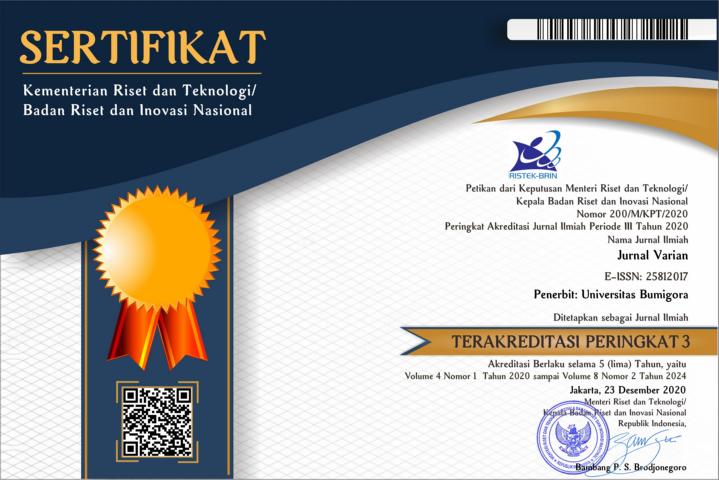Using SAPR Model for Solution of Social Poverty Problem Due to Covid-19 in Makassar City
Abstract
This study aims to build an SAPR model on the problem of poverty, analyze the model, predict the
number of poverty rates in the city of Makassar, and determine the parameters that affect the decrease
in the number of poverty rates due to Covid-19 in the city of Makassar. This research is quantitative.
The population of this study is the number of people in Makassar City who are affected by the spread
of COVID-19, while the sample of this study is 400 people. The research stages are: Building the
SAPR model on the level of social poverty, determining and analyzing the stability of the equilibrium
point, determining the value of the basic reproduction number (R0), conducting model simulations
using Maple. The results shown that the mathematical model of SAPR which is a non-linear system of
differential equations can be a reference model for the problem of poverty; The results also shown that
the analysis of the social poverty level of the population finds two equilibrium points, namely the free
equilibrium point for the poor and the poor; the stability of the equilibrium point is free-poor and poor;
The basic reproduction number R0 = 0.426 indicates that the poverty level of the social population
can be controlled even though it has increased. Based on the model simulation, it was found that the
parameter in the form of business funding assistance from the government could reduce the poverty
rate due to the Covid-19 pandemic in Makassar city.
References
Parameter: The Case of Indonesia. Advances in Difference Equations, 2021(1).
Annas, S., Isbar Pratama, M., Rifandi, M., Sanusi, W., and Side, S. (2020). Stability Analysis and Numerical Simulation of SEIR
Model for Pandemic COVID-19 Spread in Indonesia. Chaos, Solitons and Fractals, 139:110072.
Anwar, A., Syam, R., Pratama, M. I., and Side, S. (2021). SEIRS Model Analysis for Online Game Addiction Problem of Mathematics Students. Journal of Physics: Conference Series, 1918(4).
Asri, M., Sidjara, S., Sanusi, W., and Side, S. (2021). Analysis and Solution of The SEIRS Model for The Rubella Transmission
with Vaccination Effect Using Runge-Kutta Method. Journal of Physics: Conference Series 1899(2021)012090.
Biro Humas Kemnaker (2020). Menaker Ida: 29.12 Juta Orang Penduduk Usia Kerja Terdampak Pandemi Covid-19.
Dinas Kesehatan Provinsi Sulawesi Selatan (2021). Sulsel Tanggap Covid-19.
Fauzia, M. (2021). Penduduk Miskin Indonesia Naik Jadi 27.55 Juta Akibat Covid-19, Tren Penurunan Kemiskinan Terhenti.
Kementerian Kesehatan, R. I. (2021). COVID 19 di Indonesia.
Maryam, H., Abdy, M., Alimuddin, and Side, S. (2021). SEIAS-SEI Model on Asymptomatic and Super Infection Malaria with
Imperfect Vaccination. Journal of Physics: Conference Series, 1918(4).
Nur, W., Rachman, H., Abdal, N. M., Abdy, M., and Side, S. (2018). SIR Model Analysis for Transmission of Dengue Fever
Disease with Climate Factors Using Lyapunov Function. Journal of Physics: Conference Series, 1028(1).
Nurhaeda, Anas, S., and Side, S. (2021). Analysis and Simulation of Mathematical Model for Typhus Disease in Makassar. Journal
of Physics: Conference Series, 1918(4):0–6.
Ristyaningrum, A. (2020). Kemiskinan di Makassar Meningkat Signifikan.
Sanusi, W., Pratama, M. I., Rifandi, M., Sidjara, S., Irwan, and Side, S. (2021). Numerical Solution of SIRS Model for Dengue
Fever Transmission in Makassar Citywith Runge Kutta Method. Journal of Physics: Conference Series, 1752(1).
Sauddin, A., Alwi, W., and AN, A. N. (2019). Klasifikasi Tingkat Partisipasi Angkatan Kerja Kota Makassar Menggunakan Metode
CART Adnan Sauddin. Jurnal MSA, 7(2):20–36.
Setiati, S. and Azwar, M. K. (2020). COVID-19 and Indonesia. (April).
Shereen, M. A., Khan, S., Kazmi, A., Bashir, N., and Siddique, R. (2020). COVID-19 Infection: Origin, Transmission, and
Characteristics of Human Coronaviruses. Journal of Advanced Research, 24:91–98.
Side, S., Abdy, M., Arwadi, F., and Sanusi, W. (2021). SEIRI Model Analysis Using The Mathematical Graph as a Solution for
Hepatitis B Disease in Makassar. Journal of Physics: Conference Series, 1899(1).
Side, S., Muzakkir, N., Pebriani, D., and Utari, S. (2020). Model SEIR Kecanduan Game Online pada Siswa di SMP Negeri 3
Makassar. Jurnal Sainsmat, 9(1):91–102.
Side, S., Sanusi, W., Aidid, M. K., and Sidjara, S. (2016). Global Stability of SIR and SEIR Model for Tuberculosis Disease
Transmission with Lyapunov Function Method. Asian Journal of Applied Sciences, 9(3):86–96.
Singhal, T. (2020). Review on COVID19 Disease So Far. The Indian Journal of Pediatrics, 87(April):281–286.
Torrealba-Rodriguez, O., Conde-Gutierrez, R. A., and Hern ´ andez-Javier, A. L. (2020). Modeling and Prediction of COVID-19 in ´
Mexico Applying Mathematical and Computational Models. Chaos, Solitons and Fractals, 138.
WHO (2021). COVID-19 Coronavirus Pandemic.
Yang, C. and Wang, J. (2020). A Mathematical Model for The Novel Coronavirus Epidemic in Wuhan, China. HHS Public Access,
17(3):2708–2724.

This work is licensed under a Creative Commons Attribution 4.0 International License.


















